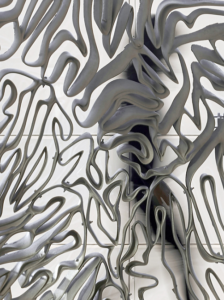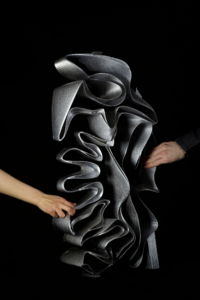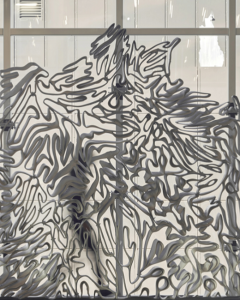 The innovative researchers at ETH Zurich in Switzerland are becoming quite well-known for their advanced design and construction techniques, especially when it comes to their work with molds. 3D printed molds can be used to help fabricate everything from jewelry and chess pieces to medical implants and wind turbines, but a group of masters students from the university’s Architecture and Digital Fabrication course are currently interested in creating 3D printed molds for the architecture field.
The innovative researchers at ETH Zurich in Switzerland are becoming quite well-known for their advanced design and construction techniques, especially when it comes to their work with molds. 3D printed molds can be used to help fabricate everything from jewelry and chess pieces to medical implants and wind turbines, but a group of masters students from the university’s Architecture and Digital Fabrication course are currently interested in creating 3D printed molds for the architecture field.
Together with ETH Zurich senior researcher Mania Aghaei Meibodi, they have developed a new method for casting complex metal architectural structures using 3D printed molds.
Aghaei Meibodi, who researches how 3D printing can help create bespoke metal building elements, said, “Cast metal parts have a long tradition in architecture due to their extraordinary structural properties and possible 3D form.
“Today the amount of manual labour involved, especially in the mould-making process makes them too expensive.
“With our approach using 3D-printed moulds, we make it possible and affordable again to fabricate bespoke structural metal parts — parts with unseen richness of detail and geometric complexity.
“This approach can unlock an entirely new vocabulary of shapes for metal structures in architecture, previously unavailable with traditional mould-making systems.”
 The one-off aluminum structure created by the Digital Building Technologies (DBT) group, called Deep Facade, is the first metal facade to be cast in 3D printed molds. Standing six meters high and four meters wide, the structure features ribbons of metal organically looped in a way that resembles the human brain’s cerebral cortex folds, and is a follow-up to a project by last year’s students called the Digital Metal Pavilion.
The one-off aluminum structure created by the Digital Building Technologies (DBT) group, called Deep Facade, is the first metal facade to be cast in 3D printed molds. Standing six meters high and four meters wide, the structure features ribbons of metal organically looped in a way that resembles the human brain’s cerebral cortex folds, and is a follow-up to a project by last year’s students called the Digital Metal Pavilion.
Aghaei Meibodi told Dezeen that the aluminum Digital Metal Pavilion, a space-frame structure made up of 240 non-repetitive joints, was the very first architectural structure to use 3D printed molds.
It only took a week to make these joints, which Aghaei Meibodi, who also chairs the DBT group, explained is 80 times faster than the more conventional processes used to fabricate complex metal parts. Using 3D printing for this type of application is obviously a far more cost-effective way to produce complex structures and forms for custom architectural projects.
It is possible to 3D print metal directly, but it’s not always the best option – it can be expensive, and can only be used with a limited range of metals with limited material properties. That’s why the DBT group uses 3D printed sand molds in casting molten metal.
Aghaei Meibodi explained, “In this synergy we benefit from the geometric freedom offered by 3D printing and the structural stability of cast metal.”
 The Deep Facade structure is made of 26 articulated panels. A differential growth algorithm, which replicates the development of some living organisms, was used to fabricate the structure, which features some sections that would have been too fragile to make with concrete or sandstone.
The Deep Facade structure is made of 26 articulated panels. A differential growth algorithm, which replicates the development of some living organisms, was used to fabricate the structure, which features some sections that would have been too fragile to make with concrete or sandstone.
Topology optimization, which allows for designers to take advantage of the geometrical freedoms made possible through additive manufacturing, also came into play in the DBT group’s creative process.
“Computational techniques such as topology optimisation allow designers to design lightweight parts, but the parts optimised with this technique are often difficult to manufacture through traditional methods.
“Our proposed fabrication approach doesn’t encounter the same limits as traditional manufacturing methods and can go further with shape optimisation thanks to the ability of 3D printing to print complex moulds that could be used to fabricate more efficient structures,” said Aghaei Meibodi.
Aghaei Meibodi is hopeful that her student group’s new method can one day be applied to a unique, large-scale project.
“With this new approach of casting metal, one can imagine a return of 3D detailing and 3D articulation, perhaps a fusing of ornament and structure,” she said.
“My dream application of it would be in the building envelope and interior structure of large spaces as large-span supporting structures.”
Discuss this story and other 3D printing topics at 3DPrintBoard.com or let us know your thoughts in the Facebook comments below.
[Images via Dezeen]





45 Replies to “ETH Zurich Students Cast Elaborate Metal Architectural Structures with 3D Printed Molds”
Comments are closed.